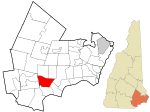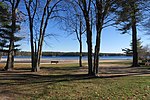Hampstead Meetinghouse
1768 establishments in New Hampshire18th-century churches in the United StatesChurches completed in 1768Churches in Rockingham County, New HampshireChurches on the National Register of Historic Places in New Hampshire ... and 4 more
City and town halls in New HampshireCity and town halls on the National Register of Historic Places in New HampshireHampstead, New HampshireNational Register of Historic Places in Rockingham County, New Hampshire

The Hampstead Meetinghouse, also once known as Hampstead Town Hall, is a historic meeting house at 20 Emerson Avenue in Hampstead, New Hampshire. The core of this dual-purpose (religious and civic) structure was begun in 1749, although its interior was not completely finished until about 1768. It is one of a number of fairly well-preserved 18th-century meeting houses in southeastern New Hampshire, and was listed on the National Register of Historic Places in 1980.
Excerpt from the Wikipedia article Hampstead Meetinghouse (License: CC BY-SA 3.0, Authors, Images).Hampstead Meetinghouse
Emerson Avenue,
Geographical coordinates (GPS) Address Nearby Places Show on map
Geographical coordinates (GPS)
| Latitude | Longitude |
|---|---|
| N 42.875555555556 ° | E -71.18 ° |
Address
Emerson Avenue
03841
New Hampshire, United States
Open on Google Maps








